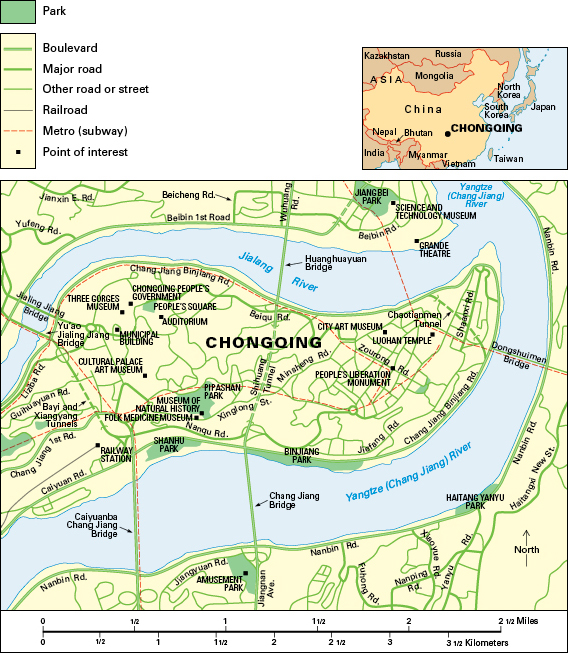Chongqing, << chuhng chihng >> (pop. 9,840,000), also spelled Chungking or Ch’ung-ch’ing, is one of China’s leading commercial, transportation, and industrial centers. The city served as the capital of the Republic of China from 1938 to 1946. Chongqing stands in a mountainous region in south-central China at the junction of the Yangtze and Jialing rivers.

In 1997, Chongqing and its surrounding area became one of China’s four municipalities that are governed directly by the national government. These metropolitan areas have a political status similar to that of a province. The other nationally governed municipalities are Beijing, Shanghai, and Tianjin. The Chongqing Municipality covers about 31,700 square miles (82,000 square kilometers) and has more than 30 million residents. It is China’s largest nationally governed municipality in both area and population.
Chongqing has been a major inland port since ancient times. Its factories produce a wide variety of goods, including automobiles and other vehicles, iron and steel, leather, medicine, paper, processed foods, and cotton and silk. The city also has several copper and petroleum refineries.
Chongqing has a history of more than 4,000 years. It became part of China in 220 B.C., when the emperor Shi Huangdi brought the territory under his rule.
Chongqing served as the wartime capital of China from 1938 to 1946. The Chinese Nationalist government moved to Chongqing after Japanese forces had overrun the capital at Nanjing and then the temporary capital of Wuhan. Chongqing was the most heavily bombed city in China during World War II (1939-1945). Bombs destroyed many of Chongqing’s old, narrow streets, which go up hillsides in stairsteps. Nanjing again became the capital in 1946, after World War II ended.
In the late 1960’s, China’s government developed military industries near Chongqing as part of its “third line” strategy. Under this strategy, the government planned to retreat to central China in case of an attack on the east coast.
See also Yangtze River.
